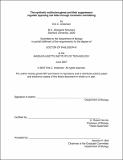The synthetic multivulva genes and their suppressors regulate opposing cell fates through chromatin remodeling
Author(s)
Andersen, Erik C
DownloadFull printable version (27.80Mb)
Alternative title
SynMuv genes and their suppressors regulate opposing cell fates through chromatin remodeling
Other Contributors
Massachusetts Institute of Technology. Dept. of Biology.
Advisor
H. Robert Horvitz.
Terms of use
Metadata
Show full item recordAbstract
The synthetic multivulva (synMuv) genes act redundantly to inhibit vulval fates in Caenorhabditis elegans. These genes are grouped into three classes called A, B and C. The class A genes encode putative transcription factors. The class B and C genes encode presumptive transcriptional repressors and chromatin-remodeling factors. The synMuv genes likely repress the transcription of the Ras pathway ligand lin-3 EGF. Some class B synMuv proteins are homologs of a Nucleosome Remodeling and Deacetylase (NuRD)-like complex and heterochromatin protein 1 (HP1). In addition to a NuRD-like complex, which deacetylates lysine nine of histone H3 (H3K9), and HP1, we found two histone methyltransferase (HMT) genes (met-1 and met-2) that act as class B synMuv genes and repress lin-3 transcription. met-1 encodes a C. elegans homolog of yeast Set2, an H3K36 HMT that inhibits the ectopic initiation of transcription, and met-2 encodes a homolog of human SETDB1, an H3K9 HMT involved in transcriptional repression. Our results link H3K36 methylation to a transcriptional repression cascade composed of the NuRD complex, H3K9 methylation and HP1 in the inhibition of ectopic transcriptional initiation. We found that not only do the class A and B synMuv genes act redundantly to inhibit vulval fates, but most genes within each class act in parallel. Pairs of genes, which act together biochemically, function in a single activity in vulval cell-fate specification. Our findings offer an opportunity to determine molecular activities for uncharacterized but conserved synMuv proteins. (cont.) We identified the isw-1 synMuv suppressor gene, a homolog of the Drosophila ATP-dependent chromatin-remodeling enzyme ISWI. ISW-1 likely acts as part of a NURF-like complex with at least the C. elegans NURF301 homolog, to antagonize the synMuv genes in the control of multiple cell-fate decisions. Our results suggest that the NURF-like complex is required in the absence of the synMuv genes to promote the expression of lin-3 EGF. We found an lst-3 gain-of-function mutation that suppresses the synMuv phenotype perhaps by repressing lin-3 EGF transcription. lst-3 encodes a homolog of the mammalian transcription factor CARP-1. Our results suggest that CARP-1 is a tumor-suppressor gene acting by Ras pathway inhibition.
Description
Thesis (Ph. D.)--Massachusetts Institute of Technology, Dept. of Biology, February 2008. This electronic version was submitted by the student author. The certified thesis is available in the Institute Archives and Special Collections. Includes bibliographical references.
Date issued
2008Department
Massachusetts Institute of Technology. Department of BiologyPublisher
Massachusetts Institute of Technology
Keywords
Biology.